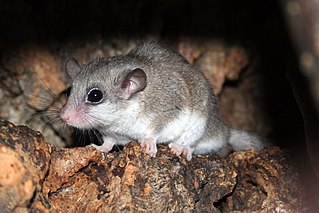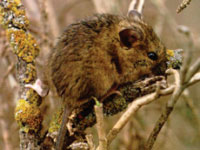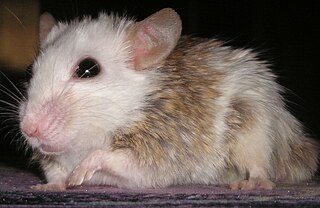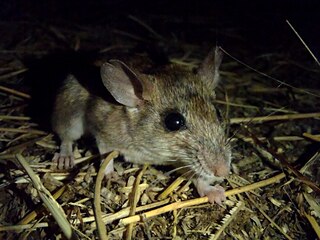
Chevrotains, or mouse-deer, are diminutive, even-toed ungulates that make up the family Tragulidae, and are the only living members of the infraorder Tragulina. The 10 extant species are placed in three genera, but several species also are known only from fossils. The extant species are found in forests in South and Southeast Asia; a single species, the water chevrotain, is found in the rainforests of Central and West Africa. In November 2019, conservation scientists announced that they had photographed silver-backed chevrotains in a Vietnamese forest for the first time since the last confirmed sightings in 1990.

A dormouse is a rodent of the family Gliridae. Dormice are nocturnal animals found in Africa, Asia, and Europe. They are named for their long, dormant hibernation period of six months or longer.

Dendromurinae is a subfamily of rodents in the family Nesomyidae and superfamily Muroidea. The dendromurines are currently restricted to Africa, as is the case for all extant members of the family Nesomyidae. The authorship of the subfamily has been attributed to both Alston, 1876, and (incorrectly) to G. M. Allen, 1939.

The Old World rats and mice, part of the subfamily Murinae in the family Muridae, comprise at least 519 species. Members of this subfamily are called murines. In terms of species richness, this subfamily is larger than all mammal families except the Cricetidae and Muridae, and is larger than all mammal orders except the bats and the remainder of the rodents.

Apodemus is a genus of Muridae. The name is unrelated to that of the Mus genus, instead being derived from the Greek ἀπό-δημος.

Mice in the genus Dendromus are commonly referred to as African climbing mice or tree mice, although these terms are often used to describe all members of the subfamily Dendromurinae. The genus is currently restricted to sub-Saharan Africa, but fossils classified in the genus have been found from Late Miocene deposits in Arabia and Europe.

Reithrodontomys is the genus of groove-toothed New World harvest mice.
Habromys is a genus of rodent in the family Cricetidae, found in Mexico and Central America. It contains these species, all but one of which are threatened or endangered, five of them critically so. H. lophurus is near threatened.
The Forrest's mouse, or desert short-tailed mouse, is a small species of rodent in the family Muridae. It is a widespread but sparsely distributed species found across arid and semi-arid inland Australia, commonly found in tussock grassland, chenopod shrubland, and mulga or savannah woodlands.

The Lakeland Downs mouse is a species of rodent in the family Muridae. It is found only in Australia. Its natural habitat is dry savanna.

Mastomys is a genus of rodent in the family Muridae endemic to Africa. It contains eight species:

Praomys is a genus of rodent in the family Muridae endemic to Sub-Saharan Africa. It contains the following species:
The silky mouse is a small, nocturnal rodent native to the western and northwestern regions of Victoria, Australia. Weighing 16-22 grams, it has light blue-grey fur flecked with light brown and black guard hairs, and a white underside. Known for its complex burrows, the Silky Mouse favors floristically rich mallee-heath environments, especially areas near Banksia ornata, due to consistent soil moisture and food availability. The silky mouse primarily feeds on seeds, nectar, flowers, and insects. Though threatened by habitat destruction and fires, conservation efforts have led to population recovery.

The little native mouse, also known as the delicate mouse, is a species of rodent in the family Muridae. The Kunwinjku people of western Arnhem Land call this little creature kijbuk.

The sandy inland mouse is a species of rodent in the family Muridae. Also known as the Hermannsburg (Mission) false-mouse or Hermannsburg mouse, it is endemic to Australia and found widely yet sparsely through arid and semi-arid areas.

Steatomys is a genus of rodent in the family Nesomyidae. It contains the following species:

Tragulus is a genus of even-toed ungulates in the family Tragulidae that are known as mouse-deer. In Ancient Greek τράγος (tragos) means a male goat, while the Latin diminutive –ulus means 'tiny'. With a weight of 0.7–8.0 kg (1.5–17.6 lb) and a length of 40–75 cm (16–30 in), they are the smallest ungulates in the world, though the largest species of mouse-deer surpass some species of Neotragus antelopes in size. The mouse-deer are restricted to Southeast Asia from far Southern China to the Philippines (Balabac) and Java.

Hydromyini is a very large, diverse tribe of muroid rodents in the subfamily Murinae. They are the dominant native rodents in Australasia and one of only two native rodent groups there, the other being the R. fuscipes group of the genus Rattus in the tribe Rattini. They are also found in parts of Southeast Asia.














